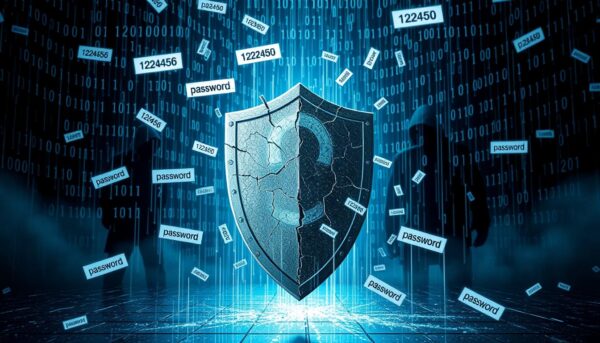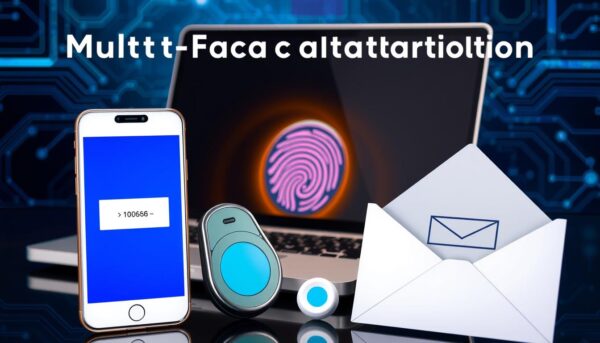✅ Last checked on
Imagine waking up to find your bank account drained or your social media hijacked. It’s a nightmare scenario that’s all too real for many. In our increasingly digital world, the need for robust online security has never been more critical. That’s where Two-Factor Authentication (2FA) comes in, offering a powerful shield against cyber threats.
You might think your password is unbreakable, but the truth is sobering. According to Verizon’s Data Breach Investigations Report, a staggering 81% of data breaches involve compromised passwords. This statistic alone should make you sit up and take notice. But here’s the kicker: implementing two-factor authentication can block up to 99.9% of automated, as reported by Microsoft.
2FA, also known as Multi-Factor Authentication (MFA), adds an extra layer of security to your online accounts. It’s like having a second lock on your front door – even if someone gets your key, they still can’t get in without the additional security measure. This simple yet effective method can make all the difference in keeping your digital life safe.
Despite its effectiveness, many people still don’t use 2FA. A study by the Ponemon Institute found that 58% of employees don’t use two-factor authentication, even when they’re aware of the risks. This gap in security practices leaves individuals and organizations vulnerable to cyber threats.
Key Takeaways
- Two-Factor Authentication significantly reduces the risk of account breaches
- 81% of data breaches involve compromised passwords
- 2FA can block up to 99.9% of automated cyberattacks
- Only 28% of users worldwide employ two-factor authentication
- Accounts with 2FA are 50% less likely to be compromised
- 58% of employees don’t use 2FA despite knowing the risks
Understanding the Limitations of Password-Only Security
Passwords alone can’t keep your online accounts safe anymore. Sophisticated hacking methods have made them weak. This leaves you open to many threats.
Common Password Vulnerabilities
Many people use weak or the same passwords everywhere. This makes it simple for hackers to get into your accounts. Security Keys and Authentication Codes are better at keeping you safe.
The Rising Threat of Data Breaches
Data breaches are happening more often. When hackers steal your login info, they can get into your accounts. One-Time Passwords add an extra layer of security, making it harder for hackers to use stolen data.

Why Traditional Passwords Fail
Traditional passwords don’t offer enough protection. Phishing scams trick people into sharing their login details. Also, hacking tools can easily guess simple passwords. Security Keys and other multi-factor authentication methods are stronger against these threats.
| Security Measure | Effectiveness | User Adoption |
|---|---|---|
| Password-Only | Low | High |
| Two-Factor Authentication | High | Moderate |
| Security Keys | Very High | Low |
Knowing these weaknesses shows why using extra security like Two-Factor Authentication is key to keeping your online world safe.
What is Two-Factor Authentication
Two-Factor Authentication (2FA) adds an extra layer of security to your online accounts. It’s a form of MFA that requires two different ways to prove who you are. This makes it much harder for hackers to get into your account.
Basic Principles of 2FA
2FA uses multiple ways to verify your identity. These include:
- Something you know (like a password)
- Something you have (such as security tokens or a mobile device)
- Something you are (biometrics like fingerprints or facial recognition)
How 2FA Protects Your Accounts
2FA keeps your accounts safe from many cyber threats. Even if hackers get your password, they still need the second factor. Microsoft says 99.9% of account hacks can be stopped with 2FA.
The Authentication Process Explained
Here’s how 2FA works when you log in:
- Enter your username and password
- Provide the second factor (e.g., enter a code from your authenticator app)
- Access is granted only after both factors are verified
| Authentication Factor | Examples | Security Level |
|---|---|---|
| Something You Know | Password, PIN | Basic |
| Something You Have | Security Tokens, Mobile Device | High |
| Something You Are | Biometrics (Fingerprint, Face ID) | Very High |
By using 2FA, you’re making a big step to keep your digital life safe. It’s a simple yet powerful way to protect your personal info from cyber threats.
Essential Components of Multi-Factor Authentication
Multi-Factor Authentication (MFA) uses many ways to verify who you are. It makes it much harder for hackers to get into your accounts. In fact, it’s 99.9% less likely than just using a password.
Something You Know
The first part of MFA is something you remember. This could be a password, PIN, or answers to security questions. But, it’s not enough to keep your accounts safe on its own.
Something You Have
The second part needs a physical item. This could be your phone getting Authentication Codes or a security token. It’s a big step up in security.
Something You Are
The third part is Biometrics. This means using your unique physical traits like fingerprints or facial recognition. It’s hard for hackers to fake, making your accounts very secure.

When you mix these three, MFA becomes a strong defense. It’s important to use MFA everywhere, as 83% of businesses without it got hacked.
| MFA Factor | Examples | Security Level |
|---|---|---|
| Something You Know | Passwords, PINs | Basic |
| Something You Have | Smartphone, Security Token | Intermediate |
| Something You Are | Fingerprint, Face Scan | Advanced |
Popular 2FA Methods and Their Security Levels
Two-Factor Authentication (2FA) offers many ways to keep your accounts safe. Let’s look at some popular 2FA methods and their security levels. This will help you pick the best for your secure home network.
SMS-based 2FA is common but has weaknesses. You get a six-digit code via text message. But, it can be hacked through SIM swapping attacks. It’s not as safe as other choices.
Mobile Authentication apps like Google Authenticator create time-based one-time passwords (TOTP). These apps work without internet and are safer than SMS. They make codes that last about 30 seconds, making it harder to intercept.
Hardware security keys are the most secure. They’re physical devices you plug into your computer or phone. They’re very safe but can be pricey and hard to carry.
Biometric authentication uses your unique traits like fingerprints or facial recognition. It’s easy and safe but can be tricked by fake images or prints.
| 2FA Method | Security Level | Convenience |
|---|---|---|
| SMS-based | Low | High |
| Authenticator Apps | Medium | Medium |
| Hardware Keys | High | Low |
| Biometrics | Medium-High | High |
Research shows 2FA makes accounts 99.9% less likely to be hacked. Pick a method that fits your needs for both safety and ease.
Implementing 2FA Across Your Digital Life
Two-Factor Authentication (2FA) is a strong way to protect your online world. With more cyber threats, it’s key to keep your accounts safe. Let’s see how to set up 2FA on different platforms.
Setting Up 2FA on Social Media
Social media sites are often targeted by hackers. Turn on 2FA on Facebook, Twitter, and Instagram for extra security. Most sites let you use SMS codes or authenticator apps for verification.
Securing Financial Accounts
Your financial accounts need strong protection. Banks and payment apps usually offer Security Keys or Mobile Authentication. These are safer than SMS-based 2FA, offering better defense against hackers.
Protecting Email Services
Email is a key to many of your accounts. Use 2FA on your email service to stop unauthorized access. This is important because a hacked email can lead to many account breaches.
Remember, 2FA isn’t always on by default. Check your account settings for options like “two-step verification” or “multi-factor authentication” to turn it on. By using 2FA across your digital life, you greatly lower the risk of unauthorized access to your accounts.
| Platform | 2FA Options | Setup Difficulty |
|---|---|---|
| Social Media | SMS, Authenticator Apps | Easy |
| Financial Accounts | Security Keys, Mobile Authentication | Moderate |
| Email Services | Authenticator Apps, Backup Codes | Easy to Moderate |
Best Practices for Managing Multiple Authentication Factors
Managing Two-Factor Authentication (2FA) is key to keeping your digital accounts safe. Let’s look at some top tips for handling Authentication Codes and Security Tokens.
Choosing the Right Authentication Apps
Picking the right 2FA app is crucial. Choose apps that are both secure and easy to use. Google Authenticator and Authy are great choices. They create time-based codes to protect your accounts.
Backup Methods and Recovery Options
It’s important to have backup plans for 2FA. Use backup codes, alternate email, or trusted devices. These options help you regain access if you lose your main method.
Device Management Tips
Managing your devices well is vital for 2FA. Here are some tips:
- Keep your devices updated with the latest security patches
- Use strong passcodes or biometric locks on devices with authentication apps
- Remove 2FA from old devices before disposing of them
- Consider using hardware Security Tokens for high-security accounts
| Authentication Method | Pros | Cons |
|---|---|---|
| Authentication Apps | High security, offline use | Requires smartphone |
| SMS Codes | Widely available | Less secure, network dependent |
| Hardware Tokens | Very secure, phishing-resistant | Can be lost, additional cost |
By following these tips, you can manage 2FA across many accounts. This boosts your digital security.
Conclusion
Two-Factor Authentication (2FA) is a game-changer in online security. It’s not just an extra step; it’s your digital shield. With 2FA, you’re 99.9% less likely to face account breaches. That’s peace of mind you can’t ignore.
The stats speak volumes. A whopping 80% of data breaches involve weak passwords. By using 2FA, you cut that risk dramatically. It’s like having a second lock on your digital door. Plus, it’s user-friendly. Most major websites support it, making it easy to secure your accounts.
Don’t wait for a breach to happen. Take action now. Enable 2FA on your critical accounts – banking, email, and social media. It’s a small step that makes a big difference. Multi-Factor Authentication is the future of online security. By embracing it today, you’re staying ahead of cyber threats. Your digital life is precious. Protect it with 2FA.